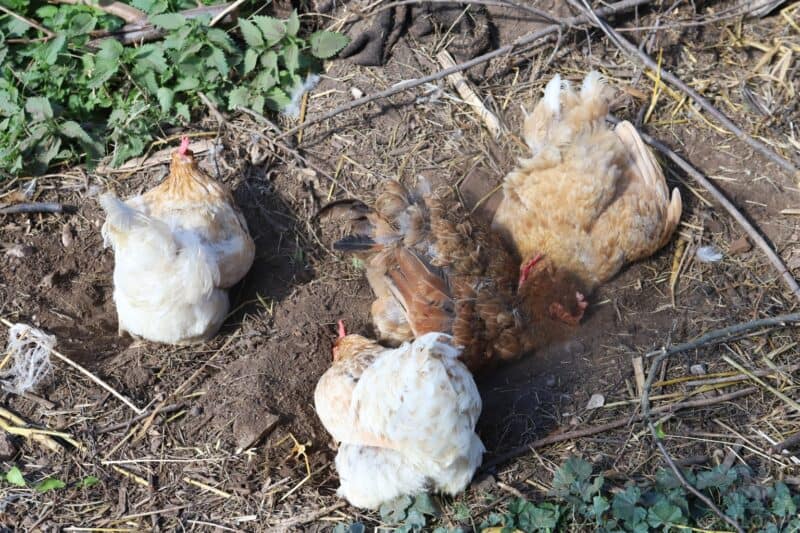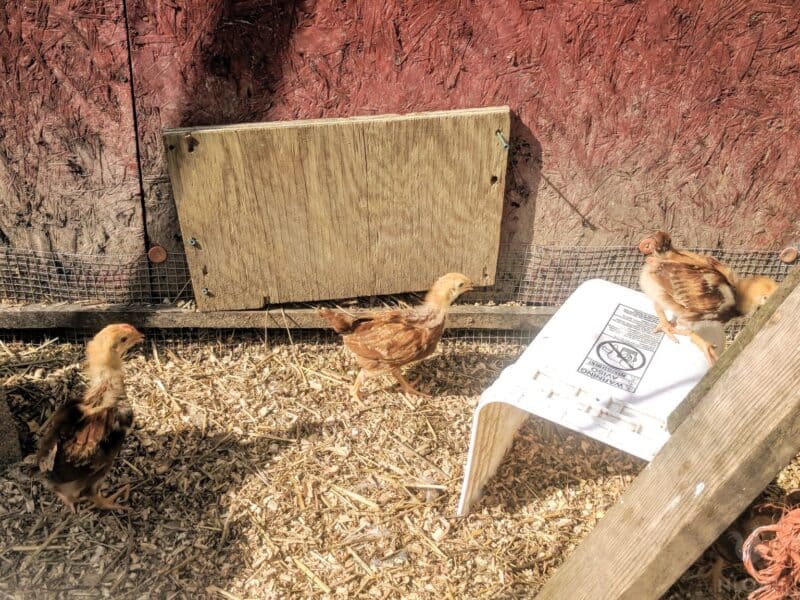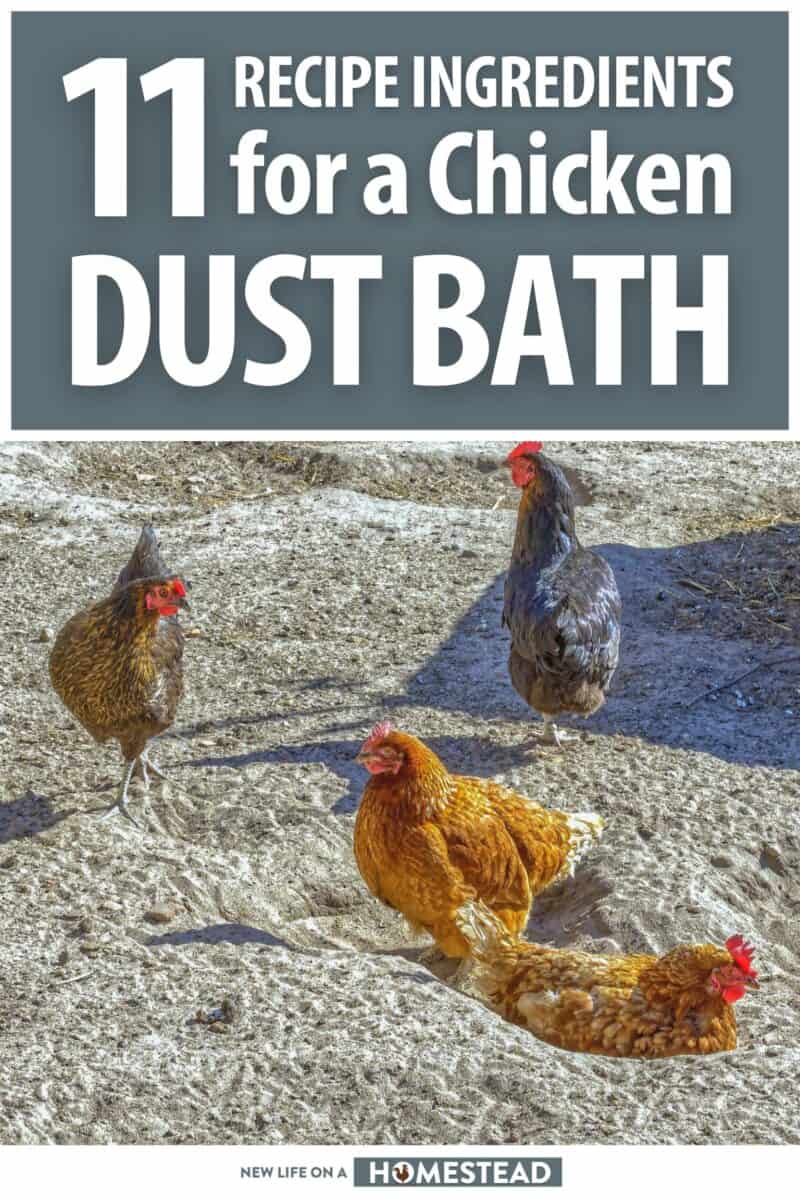Chickens are interesting creatures. Not only do they provide us with delicious eggs, but they also enjoy taking dust baths.

Dust baths help chickens stay clean and free of parasites. If you’re looking for a way to keep your chickens clean, a dust bath is a great solution.
Here are some dust bath recipes that will further enhance the benefits that they get when they’re out taking a “bath”.
Table of Contents:
What to Put Inside a DIY Chicken Dust Bath?
Here are a few key ingredients you can put inside a chicken dust bath.
1. Sand
Standard builders sand is better to use than play sand first of all because it is a lot cheaper and also because it tends to be less irritating to the skin. Play sand may have salt added to it.
If your soil is sandy, just digging up a shovel of dirt can provide you with two needed ingredients for a chicken dust bath.
The sand will help prevent the dirt mixture in the dust bath from clumping when it gets damp or wet. Both builders sand and play sand can add in the grit the chicks or chickens need and cannot get naturally if they do not free range.
2. Wood Ash
Save the wood ash from your wood burner, fireplace, or fire pit to stir into the chicken dust bath mixture.
As long as the wood ash is “clean” and consists of burning only wood or paper, it is safe for the flock members to nibble upon.
The wood ash or charcoal can help remove toxins from the body as it also helps kill the lice, dust mites, fleas, and other parasites on the outside of the chicken’s body.
3. Dirt
Shovel up some soil from anywhere on your homestead that has not been exposed to chemical agents and use it in your DIY chicken dust bath.
I use dirt from my composting pile because it also offers worms and other bugs for the hens to munch upon as a treat while bathing.
4. Diatomaceous Earth (DE)
Use food grade Diatomaceous earth to help coat the outside of parasites with even the hardest of shells.
The miniscule razor-sharp silicon pieces in the DE will become heavily coated on the outside of the parasite’s body and cause their airways to become blocked and spark dehydration.
DE has also been used as a natural dewormer and toxin-removing natural agent, making it a highly beneficial part of the chicken dust bath mixture.

5. Wood Shavings
This is an optional dust bath mixture ingredient, but one that will help soak up moisture and also tends to help chicks and juvenile birds feel more safe or like they are in a nest and not so exposed to the whole flock or potential chicken predators.
We’ll go into more detail about this below, but remember not to use pine or cedar shavings with your birds.
6. Herbs
While this is an optional part of the mixture, infusing healing herbs into the dust bath will provide a healthy free snack for the chicks or hens.
Herbs most often used in a dust bath include oregano, rosemary, basil, cinnamon, thyme, lavender, peppermint, and sage.
The best DIY chicken dust bath mixture, in my personal experience, is made of equal parts wood ash and sand, two parts dirt, and one-half to one part Diatomaceous Earth or sawdust shavings.
Stirring in roughly 1 cup of herbs on a weekly basis is highly recommended.
7. Peat Moss
Peat moss is often used as a soil amendment or conditioner. It can help to improve drainage, aeration, and water retention in soils. Peat moss is also sometimes used in chicken dust baths.
Chicken dust baths are shallow pans filled with sand or dirt that chickens use to clean themselves.
The addition of peat moss can help to absorb excess moisture and keep the bath dryer.
This can be beneficial for both the chickens and the pan itself, as damp conditions can lead to the growth of bacteria and other harmful microorganisms.
Peat moss can also help to absorb odors, making the dust bath more pleasant for both chickens and humans.
8. Charcoal
One way to make dust baths even more effective is to add charcoal to the mix. Charcoal has natural absorbing properties, so it helps to draw dirt and oil out of the feathers.
In addition, charcoal boasts antibacterial and antifungal properties, which can help to prevent skin infections.
9. Salt
Salt is a necessary electrolyte for chickens and helps to keep them hydrated. Just a small amount of salt in your chicken dust bath will help them to stay healthy and happy.
10. Baking Soda
Adding a small amount of baking soda to the dust bath can help to improve its effectiveness.
Baking soda helps to absorb moisture and oils from the feathers, leaving them cleaner and more manageable. It also has mild antiseptic properties that can help to prevent skin infections.
When using baking soda in the dust bath, be sure to follow the package directions carefully. Too much baking soda can dry out chicken skin and feathers, making them more susceptible to damage.
11. Cornstarch
Many people don’t realize that adding cornstarch to the dust bath can help to keep the feathers looking shiny and healthy.
The cornstarch helps to absorb excess oil from the feathers, and it also gives them a bit of extra support. As a result, your chickens will have fewer problems with feather damage and will stay cleaner for longer periods of time.
What NOT To Add to a Chicken Dust Bath
There are certain things that should not be added to a chicken dust bath. For example:
- ❌ Play sand or paver sand – these fine-sized particles can cause crop impaction
- ❌ Kitty litter – this contains deodorizers and fragrances, which can both cause harm to your chickens
- ❌ Commercially produced ash or wood pellets – these are from processed logs and coal fires, which can contain chemicals that might harm your birds
- ❌ Sawdust – sawdust is a good form of bedding for inside the chicken coop, but is too lightweight and absorbent for a dust bath
- ❌ Straw – straw does not retain moisture and can house mites and lice
- ❌ Pine shavings – pine shavings contain abietic acid, which can harm a chicken’s respiratory system (the same goes for cedar shavings)
What Are Some Recipes You Can Use for a Chicken Dust Bath?
Here are three recipes for chicken dust baths that you can use.
1. Sand+Soil
The first recipe is simple and only requires two ingredients:
- sand
- soil
You’ll need to mix these together in a ratio of 3:1 (three parts sand to one part soil).
Once you’ve mixed the ingredients together, put them in a container that is big enough for your chicken to fit in and enjoy a good scratch. Make sure to continuously stir the mixture so that the sand and dirt don’t separate.
2. Sand, Soil, Wood Ashes, DE
The second recipe is a bit more involved and requires four ingredients:
- sand
- dirt
- wood ashes
- diatomaceous earth
You’ll need to mix these together in a ratio of 2:1:1 (two parts sand to one part dirt to one part wood ashes). Once you’ve mixed the ingredients together, add in half a cup of diatomaceous earth per chicken.
This will help keep the mixture dry and absorb any excess moisture. Again, make sure to stir everything together so that it doesn’t separate.
3. Sand, Soil, Wood Ashes, DE, Baking Soda, Cornstarch
The third recipe is similar to the second recipe but requires six ingredients:
- sand
- dirt
- wood ashes
- diatomaceous earth
- baking soda
- cornstarch
You’ll need to mix these together in a ratio of 2:1:1 (two parts sand to one part dirt to one part wood ashes).
Once you’ve mixed the ingredients together, add in half a cup of diatomaceous earth per chicken and half a cup of baking soda per chicken. This will help keep the mixture dry and absorb any excess moisture.
Again, make sure to stir everything together so that it doesn’t separate.


Rebekah is a high-school English teacher n New York, where she lives on a 22 acre homestead. She raises and grows chickens, bees, and veggies such as zucchini (among other things).

Can you make dust bath recipe #3 without wood ash. Would this change the ratio of ingredients?
How much corn starch should I add to my dust bath?